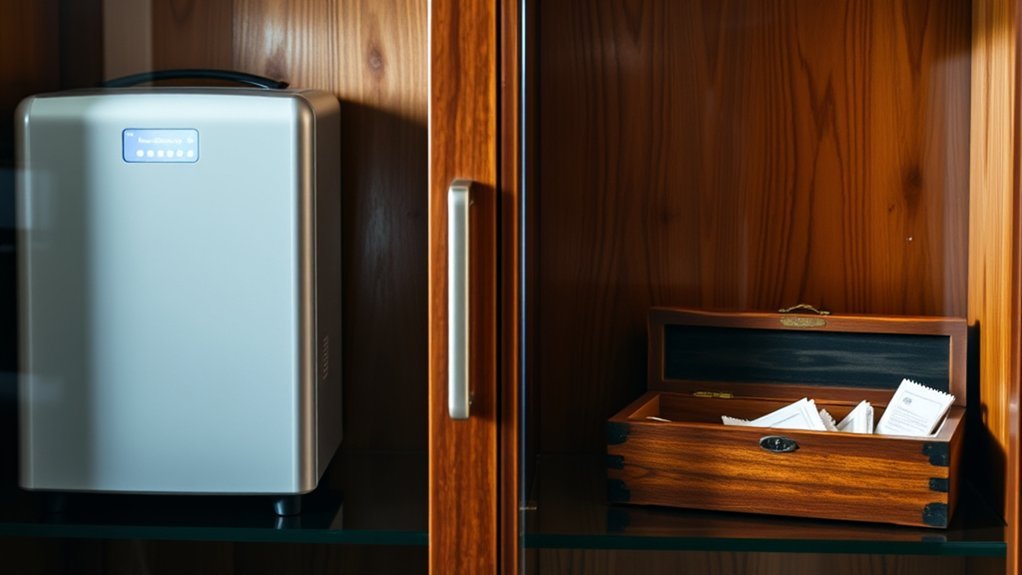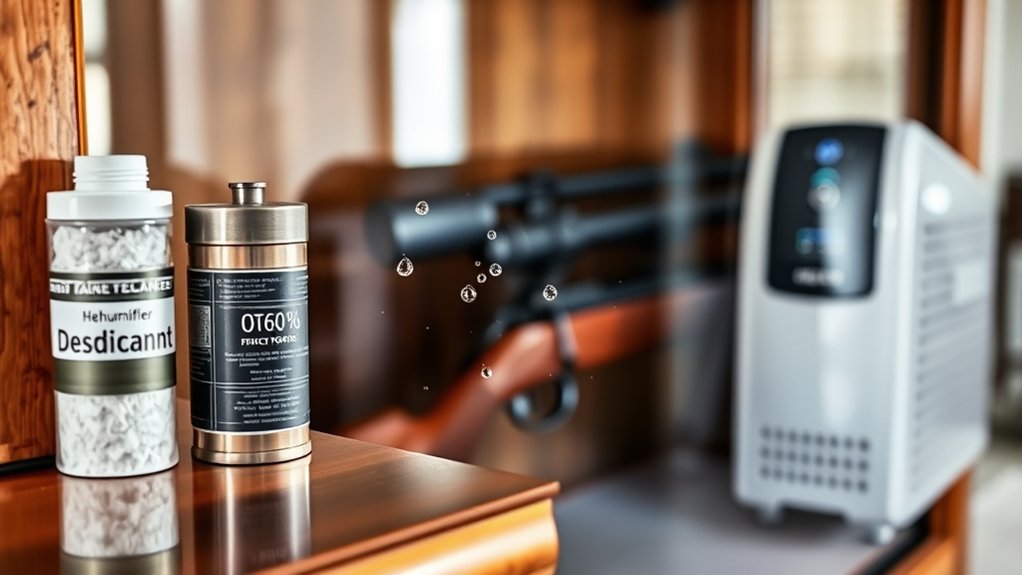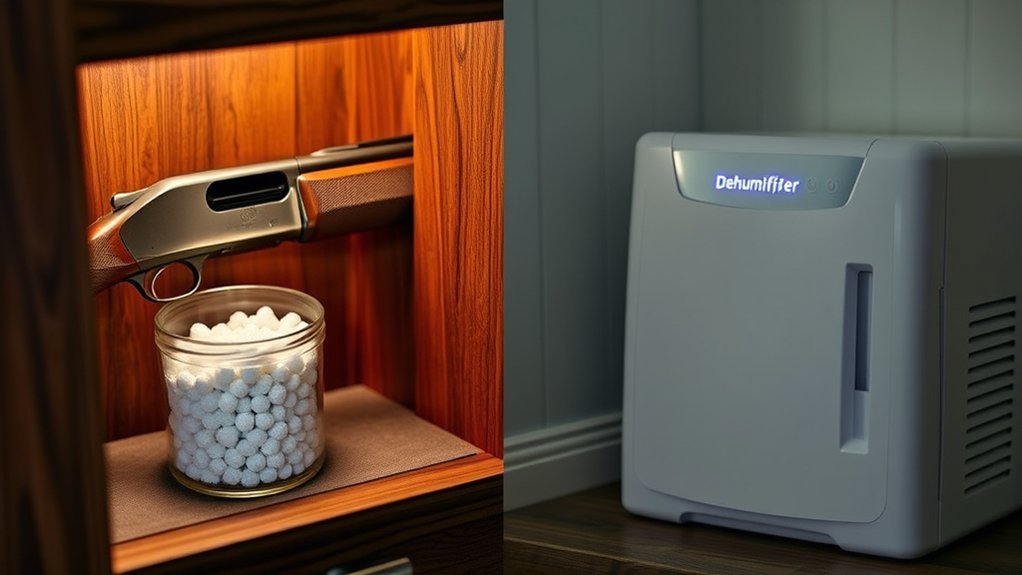It’s interesting how often gun owners overlook the importance of humidity control in their cabinets. Choosing between desiccant and electric dehumidifiers can greatly impact the longevity of your firearms. Each option has unique benefits and drawbacks, making it crucial to assess your specific needs and storage environment. Understanding these differences can help you make a more informed decision that protects your investment. What factors should you consider to guarantee ideal moisture control?
Understanding Humidity Levels in Gun Safes
When it comes to storing firearms, understanding humidity levels in gun safes is essential because excessive moisture can lead to rust and deterioration. The ideal humidity level ranges between 30% to 50%, with 30% being the most favorable. High humidity can cause significant damage, including rust on metal components and deterioration of wood stocks. Conversely, excessively dry environments can also harm your firearms, leading to wood stocks shrinking and cracking. To maintain balanced humidity levels, regularly monitor conditions with a hygrometer. Using desiccants or dehumidifiers can effectively manage humidity levels and protect your firearms from environmental damage. Both options serve vital roles in ensuring a safe and ideal storage environment for your valuable collections.
The Role of Dehumidifiers in Gun Storage

Dehumidifiers play an essential role in gun storage by effectively controlling moisture levels, which is important for preventing rust and corrosion. You’ll find that electric dehumidifiers are particularly efficient in larger cabinets, while non-electric options can work well in smaller spaces. Understanding the maintenance needs and efficiency of each type helps you choose the right solution for your firearm collection.
Moisture Control Mechanisms
Maintaining ideal humidity levels is fundamental for preserving firearms in gun cabinets, as excess moisture can lead to rust and corrosion. Dehumidifiers actively combat this issue by removing moisture from the air. Electric dehumidifiers work well in larger cabinets, continuously circulating warm, dry air to keep humidity levels between 30% and 50%. In contrast, desiccant dehumidifiers are perfect for smaller spaces, absorbing moisture without needing electricity. However, you’ll need to recharge or replace them periodically. Regularly monitoring humidity levels with a hygrometer is essential, as both high and low humidity can harm your firearms. Selecting the right dehumidifier based on cabinet size and local humidity is critical for effective moisture control.
Electric vs. Non-Electric
Whether you’re storing a single firearm or an extensive collection, choosing between electric and non-electric dehumidifiers can greatly impact the effectiveness of your humidity control strategy.
- Electric Dehumidifiers: Best for larger gun safes, they require a power source to circulate warm, dry air, effectively reducing humidity inside.
- Non-Electric Options: Desiccant beads, like silica gel canisters, are portable and ideal for smaller spaces with limited power access, absorbing moisture without generating heat.
- Considerations: Evaluate the size of your storage space, the humidity levels, and your preferences for maintenance and operational costs.
Ultimately, the right choice balances efficiency and safety, ensuring your firearms remain well-protected from moisture damage.
Maintenance and Efficiency
While effective humidity control is vital for protecting your firearms, understanding the maintenance and efficiency of your chosen dehumidification method can greatly enhance your storage strategy. Electric dehumidifiers are particularly efficient in larger gun cabinets, as they circulate warm, dry air to maintain ideal humidity levels (30% to 50%). In contrast, desiccant dehumidifiers absorb moisture effectively in smaller spaces but require regular recharging or replacement, which can diminish their efficiency over time. Monitoring humidity with a hygrometer is essential for evaluating the effectiveness of your method and making adjustments as needed. Both types help prevent mold and mildew growth, ensuring your firearms remain in peak condition and free from rust and corrosion.
Types of Dehumidifiers for Gun Cabinets

When it comes to protecting your firearms from moisture damage, understanding the different types of dehumidifiers available for gun cabinets is essential. Here are three options to evaluate:
- Electric Dehumidifiers: These plug-in devices circulate warm, dry air, making them suitable for larger cabinets with high humidity but requiring a power source.
- Desiccant Dehumidifiers: Utilizing moisture-absorbing materials like silica gel, these cordless units are ideal for smaller cabinets and need periodic recharging or replacement.
- Renewable Dehumidifiers: Combining absorbent materials with electricity, these eco-friendly options suit medium-sized cabinets but also require a power source, which may pose security concerns.
Selecting the right dehumidifier can greatly enhance your gun safe dehumidifiers’ effectiveness in maintaining ideal humidity levels.
Advantages of Desiccant Dehumidifiers
Desiccant dehumidifiers offer several advantages that make them ideal for gun cabinets. They provide cost-effective moisture control without needing electricity, making them perfect for locations without power outlets. Additionally, their lightweight and portable design guarantees easy placement in tight spaces without adding bulk.
Cost-Effective Moisture Control
If you’re looking for an effective and budget-friendly solution to control moisture in your gun cabinet, desiccant dehumidifiers are a smart choice. These devices, often using silica gel, provide a cost-effective way to prevent rust and corrosion without the need for electricity. Here are three key advantages:
- Reusable and Rechargeable: Simply heat them in an oven to restore their moisture-absorbing capabilities, cutting long-term costs.
- Non-Toxic: Safe for your valuables, they eliminate the risk of overheating or electrical hazards.
- Efficient Coverage: A single 200G unit protects about 15 cubic feet, ensuring effective moisture control.
No Electricity Required
For those seeking an efficient moisture control solution, opting for a desiccant dehumidifier offers a significant advantage: it operates without electricity. This feature makes it ideal for locations like remote gun cabinets where power sources may be unavailable. Utilizing materials such as silica gel, these dehumidifiers effectively absorb moisture from the air, protecting your firearms and valuables from rust, corrosion, and mildew. Furthermore, they do this without generating heat, guaranteeing sensitive items remain safe. Rechargeable silica gel options can be easily reactivated in an oven, providing a sustainable solution. Their compact design allows for easy placement in smaller spaces, while their non-toxic nature guarantees safety for firearms, documents, and electronics stored within confined areas.
Lightweight and Portable Design
When it comes to moisture control solutions for gun cabinets, the lightweight and portable design of desiccant dehumidifiers stands out. These devices offer several advantages that make them ideal for keeping your firearms safe and dry:
- Easy Placement: Their compact size allows you to position them effortlessly in tight spaces like gun safes or drawers.
- Flexibility: Weighing as little as 3 lbs, you can easily move or reposition the dehumidifier as needed.
- Durable Construction: Many models feature rust-resistant designs, ensuring long-term safety for your valuables.
With options like rechargeable silica gel desiccant beads, you gain an eco-friendly and cost-effective way to maintain optimal humidity levels in your gun cabinet.
Pros and Cons of Electric Dehumidifiers
Electric dehumidifiers offer a compelling solution for managing humidity levels in gun cabinets, especially in larger safes where passive methods may fall short. They effectively extract moisture from the air, circulating warm, dry air to markedly reduce humidity. They’re easy to use and often come with built-in humidity monitors for real-time adjustments. However, they require a power source, making them unsuitable for locations without electrical outlets or for users wary of electrical hazards. While operating costs are low, these devices can generate heat, potentially damaging sensitive items. Maintenance is minimal, but you’ll need to check for dust accumulation and inspect electrical components regularly to prevent humidity buildup. Weigh these pros and cons to determine what’s best for your needs.
Key Features to Consider in a Dehumidifier
While choosing a dehumidifier for your gun cabinet, several key features can significantly impact its effectiveness and safety. Prioritizing these aspects guarantees ideal moisture removal and protection for your firearms.
- Moisture Removal Capability: Look for models that maintain humidity levels between 30% to 50% to prevent rust and corrosion.
- Reliability Indicators: Choose dehumidifiers for gun safes with reliable saturation and recharging indicators, so you know when to replace desiccant materials or attend to electric components.
- Safe and Compact Design: Confirm the exterior doesn’t rust or overheat, and opt for a compact design to maximize space while assuring durability and safety.
Assessing Space and Size Requirements
Selecting the right moisture control solution for your gun cabinet hinges on understanding the space and size requirements. When you assess space, consider that a typical desiccant dehumidifier effectively absorbs moisture in areas of about 15 cubic feet per 200G of product. If your cabinet exceeds 30 cubic feet, an electric dehumidifier is often a better choice, managing humidity levels more efficiently. For smaller cabinets, desiccant dehumidifiers are ideal, as they fit easily in tight spaces and require low maintenance. Make sure that the moisture control method matches your cabinet’s dimensions and humidity levels; improper sizing can lead to moisture problems. Careful assessment will help you maintain ideal conditions for your firearms.
Maintenance Needs for Different Dehumidifiers
Maintaining the right moisture control solution for your gun cabinet requires understanding the distinct maintenance needs of desiccant and electric dehumidifiers.
- Desiccant Dehumidifiers: You’ll need to replace or recharge them every few months, depending on humidity levels. They often lack saturation indicators, so manual performance checks are vital.
- Electric Dehumidifiers: These generally require less frequent upkeep. Regularly check the water reservoir for drainage and make sure the power source is functional. Built-in indicators can help monitor moisture levels.
- Renewable Models: Some can operate continuously but may need to be plugged in for recharging.
Regular maintenance for all types is essential to guarantee peak functionality and protect your valuables from moisture damage.
Monitoring Humidity Levels Effectively
How can you guarantee your gun cabinet remains a safe haven for your firearms? Utilizing a hygrometer is essential for monitoring humidity levels, ensuring they stay within the ideal range of 30% to 50%. This helps prevent excess moisture that can rust metal parts and damage sensitive items like ammunition and optics. Regularly check the hygrometer’s readings and opt for a digital model for precise, easy monitoring. Make sure to place the hygrometer away from direct moisture sources, like dehumidifiers, to get accurate overall readings. For best protection, consider placing a hygrometer inside the gun cabinet. This allows you to monitor humidity levels in real-time and promptly address any issues, safeguarding your valuable firearms.
Making the Right Choice for Your Gun Safe
When deciding on the best dehumidification method for your gun safe, it’s essential to assess your specific needs and circumstances. Consider the following factors to make an informed choice:
- Size of Your Safe: Small safes often benefit from desiccant options, while larger ones may require electric dehumidifiers.
- Humidity Levels: Use a hygrometer to monitor humidity; desiccants work well in low to moderate humidity, while electric dehumidifiers maintain ideal levels of 30% to 50%.
- Power Availability: If electricity isn’t an option, desiccant dehumidifiers provide a reliable, maintenance-free solution, especially if you opt for rechargeable silica gel.
Conclusion
Choosing between desiccant and electric dehumidifiers for your gun cabinet is like selecting the right guardian for your prized possessions. Each option offers unique strengths, reflecting your storage needs and lifestyle. Desiccants are nimble protectors, while electric units stand as steadfast sentinels. By understanding your space and maintenance preferences, you can guarantee your firearms remain shielded from the creeping threat of humidity, preserving their integrity like a timeless treasure locked away in a vault of care.

